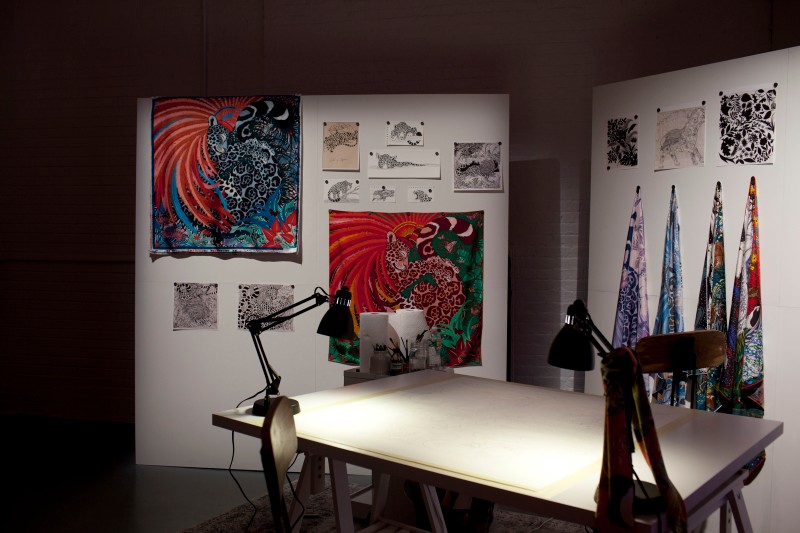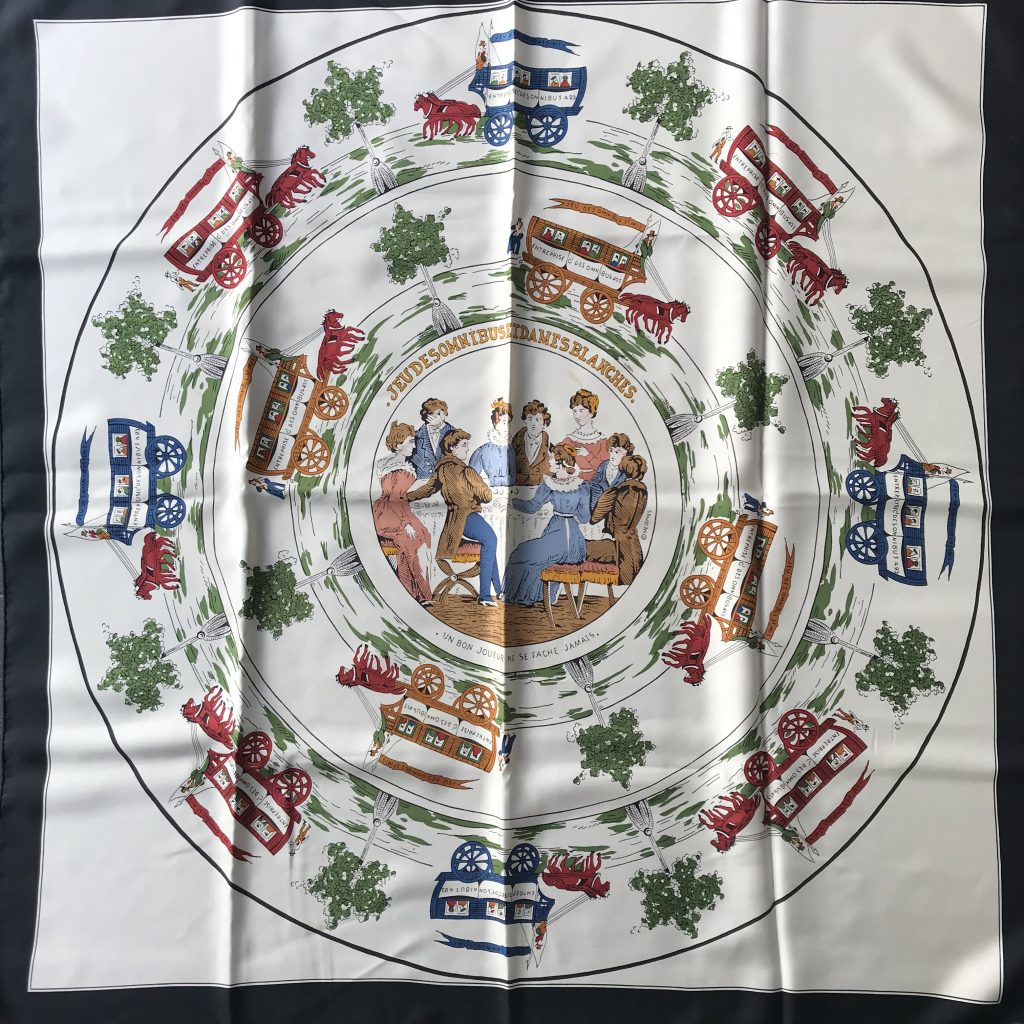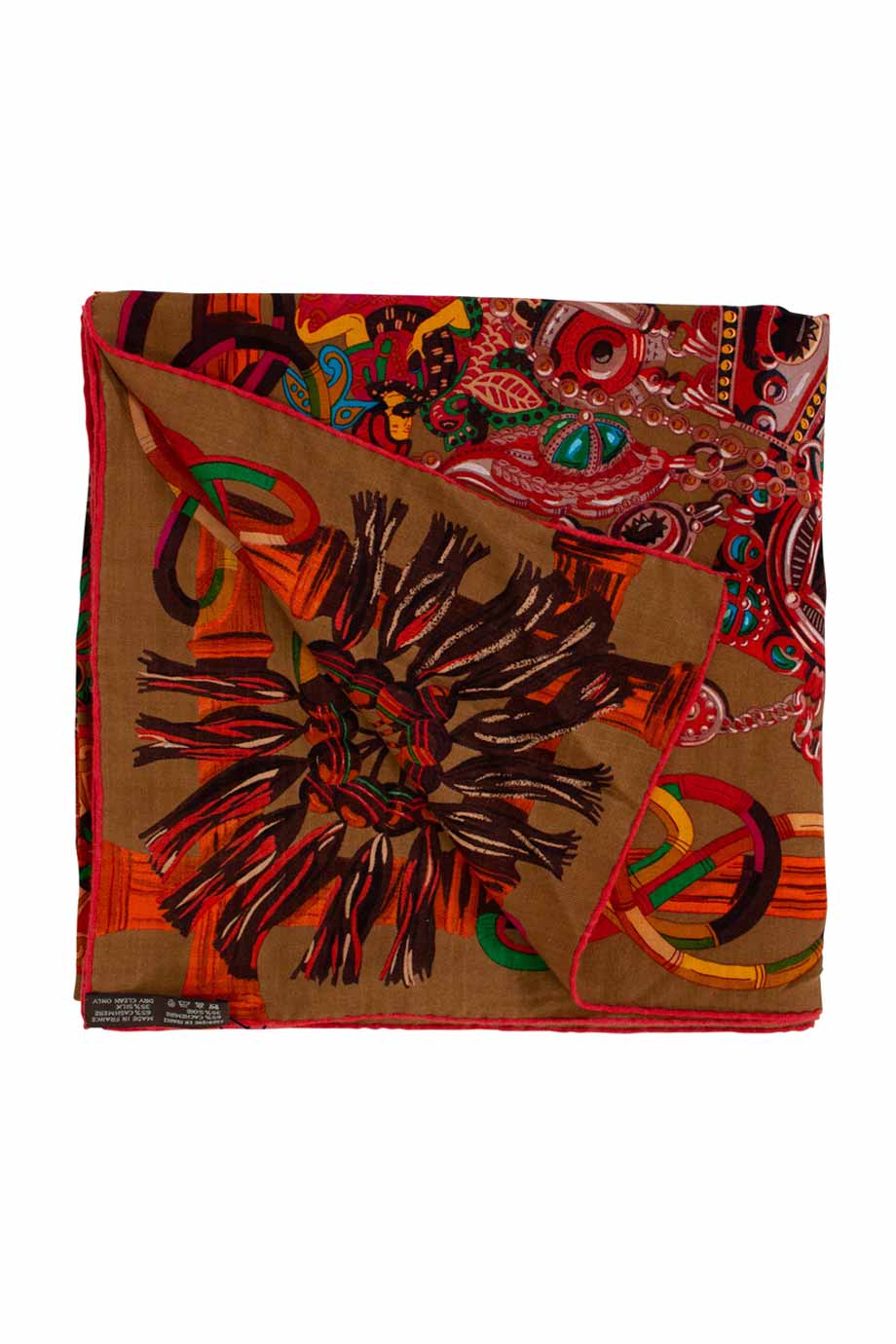The Craftsmanship and Artistic Value of Hermès Scarves
by Charlotte Banfield on Oct 21, 2021
 Hermès Carré Club, for the Love of Scarves[/caption]
Hermès Carré Club, for the Love of Scarves[/caption]
Hermès scarves are one of the most legendary accessories in the world, frequently worn by icons such as Audrey Hepburn, Grace Kelly (who famously used hers as a sling for her broken arm while boarding an airplane), and even Queen Elizabeth II. Originally created in 1937 by Robert Dumas, they instantly rose in popularity due to their colourful, hand-painted designs and the durability of the Chinese silk used. Despite demand for Hermès scarves rising significantly since their creation, Hermès still stays true to the original production methods, employing highly skilled professionals and artists to create the scarves by hand.
[caption id="attachment_14682" align="aligncenter" width="525"] The "Jeu des Omnibus et Dames Blanches" scarf, by Robert Dumas[/caption]
The "Jeu des Omnibus et Dames Blanches" scarf, by Robert Dumas[/caption]
HISTORY OF THE HERMÈS SCARF
The first Hermès scarf was created by Robert Dumas, the son-in-law of Emile Hermès, and was based on a woodblock print. The design was named the “Jeu des Omnibus et Dames Blanches”, and was made from pure silk imported from China. Since 1937, over 2000 Hermès designs have been created, with new additions being released on a seasonal basis. Hermès also re-releases a few popular scarf designs in different colours as limited edition items, but the majority of designs were only produced once. This adds to the rarity and value of owning an Hermès scarf, as owning one means that you own a piece of history. Production of Hermès scarves primarily takes place in The Holding Textile Hermès (HTH), Hermès’ textile division based in Pierre-Bénite, France. Since the 1990s, HTH has brought together ten companies dotted throughout municipalities in France, each workshop being dedicated to a specific part of the production process. Textile printing is carried out between Pierre-Bénite and Le Grand-Lemps; the manufacturing workshops are located in Bourgoin-Jallieu and Nontron; Bussières carries out weaving, and the textile engraving phases of the designs take place in Bourgoin Jallieu. [caption id="attachment_14753" align="aligncenter" width="700"] Hermès silk printing. Courtesy of Permanent Style.[/caption]
Hermès silk printing. Courtesy of Permanent Style.[/caption]
METHODS OF PRODUCTION
There is an enormous amount of time and work that goes into creating a single Hermès scarf. Hermès employs artists to design each pattern by hand, this design then being screen-printed onto the scarves. Colour experts then utilise hand-eye coordination and computer graphics to reproduce the exact colours on a separate film, a job that demands enormous levels of precision and patience. A printing frame is then used to separate surfaces from areas on the fabric where colour is applied. The wax frame is then used to reproduce the tracing on the films created by the designers, in order to reveal the subtleties of the colour details used in the patterns. Thanks to modern computer technology, the work of engravers has become easier, but it is important to note that this has not altered the freedom of interpretation of the artists, who solely determine the number of colours required to reproduce the richness of a composition. Each shade of colour is delegated a different screen, meaning that the mesh-covered frames must be perfectly aligned in order to avoid the slightest shift in positioning or colour. This process is known as textile engraving. The precision of the scarves’ motifs are owed to Établissements Marcel Gandit, a textile engraver from Bourgoin-Jallieu who later joined the Hermès family in 2006 upon the death of their founder. Gandit artisans are responsible for making the printing screens used in the Lyon engraving techniques -- a skill honoured by Hermès since 1948. The collaboration between Établissements Marcel Gandit and Hermès began in Paris when Émile Hermès and Robert Dumas were searching for a partner who could precisely replicate a complicated design: “Costumes des départements de la Seine inférieure, du Calvados et de l’Orne”. Gandit was successful in achieving this through his use of tracing paper and wooden frames. The textile engraving process takes roughly 750 hours to be completed. The artisan then cuts the uppermost surface of the double warp duchess satin with a blade of sabre, only advancing a few centimetres every day, a unique weaving technique known as the Velours au Sabre. The thread is then straightened to create a bespoke motif. In recent years, Hermès workshops have begun using Lurex in their textile designs as well. Another weaving technique used by HTH is warp printing, where silk-weaving is combined with flat frame printing. The unweaving and reweaving of the warp of a fabric printed on a flat frame is a rare and exacting technique and creates extraordinary blurred and flowing effects. [caption id="attachment_14681" align="aligncenter" width="700"] Weaving process in HTH[/caption]
There are many methods of textile printing that are then used on the scarves. Flat flame printing is performed on a printing table on fabric with a total width of 160cm. This is normally used on high-end fashion accessories, such as scarves, stoles, ties, sheets etc. This technique is also used for the Hermès Ready-to-Wear lines and ensures pieces made are of the highest quality possible. Another form of printing is digital printing. Digital inkjet textile printing is compatible with any material and can handle designs made up of millions of colours, and adds to the range of creative effects produced by screen printing. A newer printing method, known as PEPS, is an independent flat frame printing workshop with its own colour mixing station. This is typically used for prototypes, samples and small runs of production. The process of textile printing is carried out by Atelier AS, a textile printer based in Pierre-Bénite that was founded in 1937. Atelier AS’ artisans must undergo three years of training before they are able to become a qualified artisan, the first two years being devoted to training their craft with a tutor. Atelier AS’ artisans have been in charge of combining, mixing and applying colour to flatbed screens on silk since 1948, when Émile Hermès and Robert Dumas discovered the now-signature Lyon printing process. This process was developed by the chemist Auguste Arnaud, the colour specialist Aimé Savy and Marcel Gandit. In order to create a successful print, an artisan must take the baton every 40 metres, manage the colour, regulate speed, and check that the printing markers are observed. The dyes must then be fixed in steam, then washed, rinsed and dried, before the textile printing process can be considered finished.
[caption id="attachment_14751" align="aligncenter" width="700"]
Weaving process in HTH[/caption]
There are many methods of textile printing that are then used on the scarves. Flat flame printing is performed on a printing table on fabric with a total width of 160cm. This is normally used on high-end fashion accessories, such as scarves, stoles, ties, sheets etc. This technique is also used for the Hermès Ready-to-Wear lines and ensures pieces made are of the highest quality possible. Another form of printing is digital printing. Digital inkjet textile printing is compatible with any material and can handle designs made up of millions of colours, and adds to the range of creative effects produced by screen printing. A newer printing method, known as PEPS, is an independent flat frame printing workshop with its own colour mixing station. This is typically used for prototypes, samples and small runs of production. The process of textile printing is carried out by Atelier AS, a textile printer based in Pierre-Bénite that was founded in 1937. Atelier AS’ artisans must undergo three years of training before they are able to become a qualified artisan, the first two years being devoted to training their craft with a tutor. Atelier AS’ artisans have been in charge of combining, mixing and applying colour to flatbed screens on silk since 1948, when Émile Hermès and Robert Dumas discovered the now-signature Lyon printing process. This process was developed by the chemist Auguste Arnaud, the colour specialist Aimé Savy and Marcel Gandit. In order to create a successful print, an artisan must take the baton every 40 metres, manage the colour, regulate speed, and check that the printing markers are observed. The dyes must then be fixed in steam, then washed, rinsed and dried, before the textile printing process can be considered finished.
[caption id="attachment_14751" align="aligncenter" width="700"] Hermès silk printing. Courtesy of Permanent Style.[/caption]
The silk is then cut into squares, and seamstresses hand-roll and sew the edges with silk thread. This hand-rolled hem is an indicator of an authentic Hermès scarf.
[caption id="attachment_14752" align="aligncenter" width="700"]
Hermès silk printing. Courtesy of Permanent Style.[/caption]
The silk is then cut into squares, and seamstresses hand-roll and sew the edges with silk thread. This hand-rolled hem is an indicator of an authentic Hermès scarf.
[caption id="attachment_14752" align="aligncenter" width="700"] Artisan at work | Hand rolled hem[/caption]
As Hermès hires artists from around the world to design patterns for the scarves, their inspirations tend to be drawn from different cultures. The title of these artworks are usually named and incorporated into the designs of the scarves.
[caption id="attachment_14834" align="aligncenter" width="920"]
Artisan at work | Hand rolled hem[/caption]
As Hermès hires artists from around the world to design patterns for the scarves, their inspirations tend to be drawn from different cultures. The title of these artworks are usually named and incorporated into the designs of the scarves.
[caption id="attachment_14834" align="aligncenter" width="920"] "Sous L Egide de Mars" Scarf | Hermès[/caption]
"Sous L Egide de Mars" Scarf | Hermès[/caption]
The “SOUS L’ÉGIDE DE MARS” SCARF
Original Price: 1785 AUD/ 10209.90 HKD The “Sous L’égide de Mars'' scarf was designed by Pierre Marie (real name: Pierre-Marie Agin), a Parisian artist who was the youngest artist ever to create scarves for Hermès. Pierre has stated before in interviews that his travels around the globe cause him to be “loaded with inspiration”, which becomes evident in his work. The scarf's design was inspired by the Mannerism style that grew in popularity at the height of the Italian Renaissance, a style that was characterised especially through its attention to detail and ornamentation. The title “Sous L’égide de Mars” translates to “Under the Aegis of Mars”, referencing the shield of Mars, the Roman god of war, in Roman mythology. This title was also a tribute to the Musée de l’Armée in Paris’ exhibition of the same name, as the scarf was created in collaboration with them. The motif for this scarf is centred around the battles of a medieval knight, and thus heavily features armour such as breastplates, shoulder-and-knee pieces, shields and chamfrains that are richly decorated with medallions recounting his episodes, which mimic the famous Twelve Labours of Hercules. Techniques used in the creation of this scarf include repoussé work, engraving, gliding and damascening, the suit of armour itself taking an entire year to complete. The message of the scarf ultimately alludes to the art of protecting ourselves from the blows of our enemies, while simultaneously impressing them with our finery at the same time. This vision is quintessential Pierre Marie, who has a unique way of combining respect for the antiquated and traditional with a contemporary vision and a brilliantly singular use of colour. [caption id="attachment_14837" align="aligncenter" width="920"] "Au fil du Carre" Scarf | Hermès[/caption]
"Au fil du Carre" Scarf | Hermès[/caption]
THE “AU FIL DU CARRÉ” SCARF
Original Price: Unknown The “Au Fil du Carré” scarf was designed by Annie Faivre, a French artist who has created multiple scarf designs for Hermès. Faivre began working for the fashion house in 1979, and her unique, immediately recognisable style of design has garnered her a loyal fan base across the world. Scarves by Faivre have more abstract motifs, as compared to incredibly detailed works of other artists, and offer a passing resemblance to Moorish carvings. Scarves designed by Faivre are especially popular with customers, as each design features a little monkey hidden somewhere in the tableau. [caption id="attachment_14836" align="aligncenter" width="920"] "Acte III, Scene I, La Clairiele" Scarf | Hermès[/caption]
"Acte III, Scene I, La Clairiele" Scarf | Hermès[/caption]
“ACTE III, SCENE I, LA CLAIRIERE"
Original Price: 9600 HKD The “Acte III, Scene I, La Clairiere” scarf was designed by Edouard Baribeaud. Known for his vividly imagined and incredibly detailed designs, Baribeaud and his partner Sophia Andreotti create work that draws on fairytale, mythology and fine art to invoke a sense of mystery. This is made evident in this scarf, whose title is taken from Shakespeare’s famous play “A Midsummer Night’s Dream”. The comedy was written in the late 16th century, and comments on the absurdity and confusion caused by falling in love, along with magic, mischief and an actor who gets metamorphosed into a donkey. Through the illustration of the scene, Baribeaud not only pays homage to Baroque theatre, but transports the wearer to a world of whimsy and the intangible. [caption id="attachment_14835" align="aligncenter" width="920"] "Mythiques Pheonix" Scarf | Hermès[/caption]
"Mythiques Pheonix" Scarf | Hermès[/caption]
THE “MYTHIQUES PHOENIX” SCARF
Original Price: 2527.77 HKD The “Mythiques Phoenix” scarf was designed by Laurence Bourthoumieux. Also known as Toutsy and Laurence Thioune, she has designed a large number of scarves for Hermès. Laurence’s style varies across her body of work, from Indian-inspired decals to a painstakingly detailed illustration of Giverny that resembles Claude Monet’s famous artwork “Water Lilies”. The Phoenix is a gigantic bird featured in Greek mythology, which lives for hundreds of years, dies in a nest of myrrh in incense, and then returns to life in a blaze of fiery glory, spurring the popular phrase “reborn like a phoenix from the ashes”. The ancient Greeks associated the Phoenix with palm trees, which symbolises fertility and longevity. In the design, the Phoenix emerges from the center of the scarf amid leaves and fruits from palm trees. [caption id="attachment_14838" align="aligncenter" width="920"] "Carre Kantha" Scarf | Hermès[/caption]
"Carre Kantha" Scarf | Hermès[/caption]
THE “CARRE KANTHA” SCARF
Original Price: Unknown The “Carre Kantha” is one of the most mysterious scarves in the history of Hermès, as it is one of the few where the designer of the scarf remains unknown to this day. The design is unsigned as an homage to the kantha embroidery technique from Bengal. The kantha technique involves scraps of old textiles being sewn together in order to create ornate, intricately designed new fabrics, which are then turned into saris, other clothing, gifts, souvenirs etc. The “Carre Kantha” is made from silk twill, mousseline and cashmere, and is woven together in a way that creates the illusion of it being an embroidered design, thanks to the incredible skill of the artisans. Along with the Hs, traditional symbols of India such as elephants, tigers, pottery and paisley are interwoven, thus creating a unique fusion of both French and Indian design. The word “Kantha” originates from Sanskrit, and describes the pieces of fabric that hung in temples and on trees to symbolise prayers to protect citizens from the evil eye. For Bengali citizens, “Kantha” meant “quilted and embroidered fabric”, and the kantha embroidery technique is one of the earliest forms of recycling. A true kantha is described to be a unique work of art that tells a story, truly evoking the emotions and desires of the artist. Designs normally featured gods, goddesses, flowers, animal, and geometric motifs. An extraordinary amount of textile engraving was necessary to create the “Carre Kantha”, in order to suggest the delicate embroidery used in the kantha technique.











